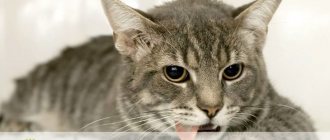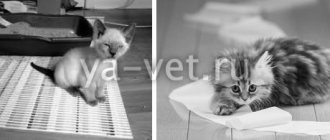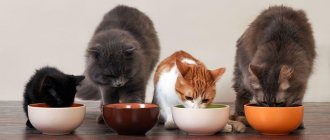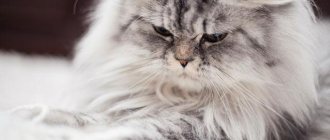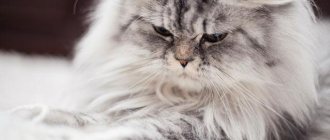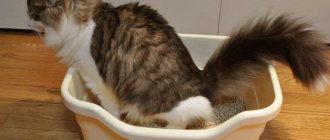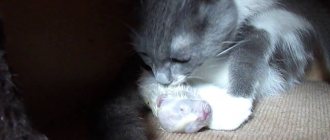- What can cause vomiting and diarrhea in cats?
- Vomiting and diarrhea in a cat what to do in case of emergency
- Diarrhea and vomiting in cats: treatment and prevention
Cats are very sensitive animals and therefore their body can react to various irritants by vomiting and/or diarrhea.
Isolated cases should not cause any particular concern to owners; it is enough to just identify the source of the trouble. It’s another matter if there is constant diarrhea and vomiting in a cat, the reasons for which may be simply banal or, on the contrary, become a herald of the development of dangerous diseases or intoxication of the body.
Possible reasons
The most common factors causing diarrhea and vomiting in a cat are:
- a sharp change in the usual diet;
- rapid swallowing of food;
- formation of trichobezoars;
- stale food and water;
- binge eating;
- stress.
Usually in such cases, nausea and diarrhea go away quickly and do not require treatment.
On a note. If your indoor cat is vomiting white foam, he may be hungry. The animal's body produces enzymes and gastric juice. They irritate the gastric mucosa and provoke vomiting.
If a cat vomits and diarrhea for a long time, then the cause of this condition may be serious diseases:
- Severe poisoning. Their sources can be medications, poor-quality food, indoor plants and detergents.
- Parasitic infestations. Some types of helminths, when ingested by a cat, quickly cause diarrhea and vomiting.
- Malignant and benign neoplasms in the gastrointestinal tract.
- Diseases of the digestive system (intestinal obstruction, pancreatitis, ulcers, colitis and gastritis).
- Malfunctions of the hormonal or immune system also provoke a disruption of normal metabolism and affect the digestive processes.
- Congenital or acquired diseases of the liver and kidneys.
- Intolerance to some substances or foods. Allergies in cats have a cumulative effect. Therefore, a reaction may suddenly appear to foods that the pet has eaten over a long period.
- Infectious diseases.
- Heat or sunstroke.
- A foreign object swallowed and stuck in the gastrointestinal tract, which, due to its large size or poor location, cannot be released naturally.
- Severe blow or injury to the abdomen. Complicated by the risk of internal bleeding.
Primary and secondary symptoms
The main sign of diarrhea in a cat is loose stool. In addition to this, the animal may experience other symptoms:
- flatulence;
- frequent attempts to defecate;
- mucus and blood in excrement.
In addition, in an adult animal or kitten, diarrhea and vomiting are often accompanied by the following secondary symptoms:
- lethargy and apathy;
- gagging;
- fever;
- dehydration;
- lack of appetite;
- weight loss.
Popular questions and answers
We also addressed a number of questions about diarrhea in cats and cats to veterinarian Ivan Malyshev - he gave a number of tips to animal owners.
How long can diarrhea last in a cat?
If your cat just gobbled up your candy, then usually the diarrhea will stop within 1 day, provided that you gave him sorbents and he goes hungry at least until the evening. If this is a symptom or a viral infection, then the diarrhea may not end on its own - treatment is needed.
What to do if a cat’s diarrhea is accompanied by vomiting?
Vomiting and diarrhea can be both a sign of poisoning and a systemic disorder. This is the most common clinical picture, ranging from obstruction to oncology.
What does yellow diarrhea mean in a cat?
Yellow diarrhea - for any diseases of the parenchyma (especially the liver). This is already a hint of a serious illness in your pet.
What does green diarrhea mean in a cat?
Green – putrefactive decay in the intestines, most often resulting from low-quality feed, rotten products. May appear due to poisoning in an animal.
What does white diarrhea mean in a cat?
White diarrhea is very bad, you need to urgently take it to the hospital. This is a symptom of blockage of the bile ducts and the formation of bile in the liver.
Why does diarrhea in cats come from water?
Probably the safest (if I may say so) type of intestinal disorder in cats, because it is usually associated with poisoning with low-quality food or unusual food for the animal. Unless accompanied by other symptoms such as mucus, blood in the stool, loss of appetite, weight loss, lethargy and vomiting, diarrhea is usually a one-time intestinal protest in the animal.
Why does my cat have diarrhea with mucus?
Diarrhea with mucus is a very dangerous thing. This is one of the first symptoms of intestinal inflammation in an animal, which means that pathogenic bacteria are multiplying in it. If there are several animals in the house, it is better to isolate the animal with such signs, make a separate toilet and bowls so that other animals do not become infected. For example, viral peritonitis in cats, a fatal disease, has one of these symptoms.
How dangerous is bloody diarrhea in cats?
Bloody diarrhea is often a sign of a fatal disease in cats, such as: inflammation in the large intestine, tumors; poisoning by poisons and chemicals, household chemicals; traumatic injuries in the rectum, intestinal rupture; acute pancreatitis; Panleukopenia is the most dangerous viral disease in cats.
Can diarrhea in cats lead to dehydration?
Maybe. Therefore, you need to give the animal water (even forcibly) or give it an IV under the supervision of a veterinarian. Well, be sure to fast for a day so that the animal’s body can rest and cleanse itself.
First aid at home
If your cat has diarrhea and vomiting, she needs to provide first aid:
- Compliance with drinking regime. The first thing to do at home if your cat has diarrhea and vomiting is to give your pet bottled or boiled water. This will help prevent the development of dehydration. If the cat refuses to drink on its own, then after each trip to the toilet it must be force-fed using a syringe without a needle.
- Following a fasting diet. Feeding a sick cat with diarrhea and vomiting is prohibited. Fasting will help minimize the burden on the digestive organs.
- Removing toxins. Diarrhea and vomiting in a cat cause severe intoxication of the body. To avoid this, the animal can be given 2-3 tablets of activated carbon. They must first be ground into powder and dissolved in a small volume of water. If necessary, activated carbon can be replaced with a bag of Smecta. Before giving the cat the medicine, it must be diluted in water.
What to feed a sick cat with diarrhea and vomiting
In case of diarrhea and nausea, the animal is put on hunger, but it cannot be kept without food for a long time. As soon as the condition improves, the cat is gradually fed. On the first day, give a third of the daily portion. The canned food is slightly diluted with water, and the granules are soaked to a paste.
| Can | It is forbidden |
| Rice is included in the diet. After a couple of days, you can supplement it with fermented milk products and foods containing fiber. Boil a small piece of meat and feed it chopped. Food should be soft, quickly digested, without burdening the stomach or causing irritation. | Chicken, dairy products, solid and rough foods are prohibited. In the first two days, any canned food, dry food, or fatty foods are excluded. |
Feed in small portions every 2-3 hours. They stay on this diet for a week, then switch to their previous diet.
If a cat experiences short-term vomiting or diarrhea (up to a day), it is often enough to give sorbents. They will remove toxins from the body. If attacks last more than a day or become more frequent, it is necessary to urgently take the animal to a specialist.
Diagnostic methods
Only a specialist can identify the exact cause of diarrhea and vomiting in a cat. To make a diagnosis, the following are usually prescribed:
- general blood analysis;
- biochemical study of vomit and feces;
- smear from the rectum and oral cavity;
- X-ray and ultrasound of the abdominal cavity;
- culture for salmonellosis;
- study of markers for the presence of pancreatitis or pancreatic insufficiency.
Also, during the initial appointment, the veterinarian asks the owner about the presence of vaccinations, symptoms, nutrition and duration of illness.
Symptoms of diarrhea
The symptoms of diarrhea are pronounced, the condition involves a frequent urge to empty the intestines, while the volume of a single bowel movement is less than usual, and the consistency is liquid. In addition, among the most common symptoms it is worth noting:
- acts of defecation – more than 3 times per day;
- watery, unformed stools;
- fecal incontinence, urgent urge to defecate;
- the color of the feces is light with shades of yellow, green, red if there is diarrhea with blood, and even black if the animal has damage to internal organs.
In addition, vomiting, painful spasms, lethargy, apathy and loss of appetite and other symptoms are often added to the existing picture. It is extremely important to recognize the symptoms in time and identify the root causes of the painful condition in order to understand what to do and what kind of help the cat needs.
Treatment options
Diarrhea and vomiting in a cat need to be treated comprehensively. Therapy should include special care, diet and medication. Medicines are prescribed to a cat only after receiving the results of examinations and accurately establishing the cause.
Depending on the diagnosis, the following is prescribed:
- anthelmintic drugs;
- antibiotics;
- antihistamines;
- enzymes;
- corticosteroids;
- vitamin complexes.
To remove toxins and restore intestinal microflora during diarrhea and vomiting, the cat is given the following medications:
- Lactofiltrum;
- Phosphalugel;
- Hilak Forte.
Important! Self-treatment of diarrhea and vomiting in a cat is unsafe for the health of the animal. Therefore, all appointments must be made by a qualified veterinarian.
During the first days of illness, the pet is not given anything to eat. The duration of fasting is determined depending on the severity of the pet’s condition. You need to return to your usual diet gradually. At first, the cat can be fed with special food to normalize the digestive system or rice with pieces of boiled chicken.
Gradually, you can gradually add your usual food to your food.
In some situations, when a cat has diarrhea and vomiting, surgery cannot be avoided. The operation is prescribed:
- when a foreign object is detected in the cat’s gastrointestinal tract;
- oncological diseases of the abdominal organs;
- identifying ulcers and erosions in the stomach or intestines.
Diet food
If you notice your cat has loose stools, what should you do first? It is necessary not to feed the animal anything for one day. But water should be given in large quantities. It will need to be boiled and cooled to room temperature.
While the animal is experiencing problems, it is not given any types of dairy, fermented milk products, fatty meats, or starchy foods. After one day, the patient begins to be fed in small portions. The norm is reduced by half, offering the sufferer low-fat food that is easily digestible.
The therapeutic diet involves split feeding 3-4 times a day. Prescribed medications are added to food in crushed or diluted form. Foods recommended for the disorder include:
- cooked white rice;
- boiled chicken meat without skin;
- boiled egg yolk.
Moist canned food for animals, specially designed for problem cases, are well absorbed and have an effect on the patient’s body. They do not have an irritating effect on the mucous walls of the gastrointestinal tract. It is allowed to return to the usual diet only after the mustachioed friend’s health has been completely restored.
Prevention measures
To avoid possible problems with the digestive system, the kitten must get used to a certain diet from childhood. To prevent diarrhea and vomiting in a cat, you should adhere to the following recommendations:
- The animal should be fed only fresh and high-quality food.
- New foods should be introduced into your cat's diet gradually.
- Periodically, the cat needs to be given pastes to remove hair.
- You cannot mix different types of food.
- Cat bowls need to be kept clean.
- You cannot feed the cat with leftovers from the owner's table.
- It is necessary to prevent contact between pets and street animals.
- Routine vaccination and antiparasitic treatments should not be neglected.
Diarrhea and vomiting in cats are the result of many serious diseases. Therefore, if your pet is vomiting and does not eat, it needs to be shown to a doctor. The veterinarian will determine the exact cause of the ailment and write a treatment plan.
